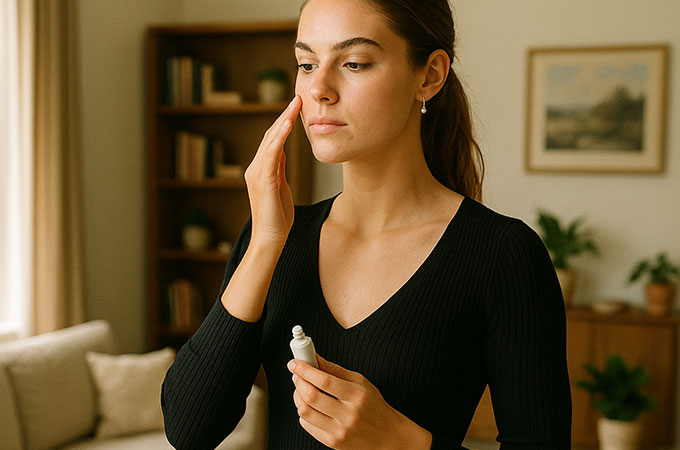That relentless itch that keeps you scratching at your skin, leaving it raw and angry—it’s more than just a nuisance. It’s atopic dermatitis, or eczema, a condition that affects up to 30 million Americans, according to the National Eczema Association. It can feel like your skin’s turned against you, flaring up at the worst times and disrupting sleep, work, even simple joys like hugging a loved one. But here’s the comforting truth: while there’s no cure, eczema is manageable, and new treatments are making life easier. Drawing from the latest guidelines, let’s break down what triggers those red, bumpy patches, why they happen, and real ways to soothe the storm.
The Telltale Signs: When Your Skin Sounds the Alarm
Eczema doesn’t announce itself with fanfare—it sneaks in with dry, itchy skin that escalates into inflamed, red rashes, often on the elbows, knees, neck, or face. In babies, it might look like weepy, crusty spots on chubby cheeks; in adults, it can be thick, leathery patches from chronic scratching. Other red flags include intense itching that worsens at night, small bumps that ooze and crust over, or skin that’s so sensitive it cracks and bleeds. The worst part? That itch-scratch cycle—scratching relieves the urge but thickens the skin, making it itchier.
A 2023 study in JAMA Dermatology surveyed over 1,000 patients and found that 80% rated itching as their top torment, often leading to sleep loss and anxiety. It’s not just cosmetic; severe flares can invite infections from bacteria like Staphylococcus aureus, turning a simple rash into a painful ordeal. If your skin’s been acting up, especially with a family history of allergies or asthma (part of the “atopic march”), it’s worth seeing a dermatologist for confirmation—often via a quick exam, no biopsy needed.
Why Me? Unraveling the Causes
Eczema feels personal, but it’s a team effort between your genes, immune system, and environment. At its core, it’s a skin barrier glitch: your epidermis lacks enough ceramides and filaggrin, proteins that lock in moisture and block irritants. This “leaky” skin lets allergens and germs sneak in, sparking an overzealous immune response—think of your body throwing a tantrum, releasing histamines and cytokines that inflame everything.
Genetics load the dice: if one parent has eczema, your odds jump 50%; both parents? Up to 80%, per a 2021 British Journal of Dermatology review. But triggers pull the lever—harsh soaps, wool clothes, pollen, pet dander, stress, or even sweat can set off flares. Food allergies play a role in kids (milk, eggs, nuts), but less so in adults. Climate matters too: dry winters or humid summers can tip the scales. A 2022 Allergy study linked urban pollution to worse symptoms, showing how our modern world amps up the risk. It’s heartbreaking for parents watching a toddler suffer, but knowing it’s not “just in your head” can ease the guilt.
Taming the Beast: Treatments That Actually Work
The goal? Break the itch cycle, heal the skin, and prevent flares. Start with the basics, then layer on as needed—your doc can tailor a plan.
Your Everyday Skin Care Toolkit:
Moisturize Like Your Life Depends On It: Slather on thick, fragrance-free creams (think petroleum jelly or ceramide-based ones like CeraVe) right after bathing, twice daily. A 2020 Journal of the American Academy of Dermatology trial showed this alone cuts flares by 50% by rebuilding the barrier.
Gentle Cleansing: Use lukewarm water and mild, soap-free cleansers—no hot showers or loofahs. Pat dry, don’t rub.
Trigger Dodging: Wear cotton over synthetics, launder new clothes before wearing, and use hypoallergenic laundry detergent. For kids, wet-wrap therapy—moisturizer under damp bandages overnight—can calm severe flares fast.
Med Options: From Creams to Cutting-Edge Shots
Topicals First: Over-the-counter hydrocortisone soothes mild itches; for stubborn spots, prescription steroids or calcineurin inhibitors (like tacrolimus) reduce inflammation without thinning skin. Newer non-steroidal creams like crisaborole (Eucrisa) target itch at the source.
For Bad Flares: Oral antihistamines ease nighttime scratching; antibiotics if infected. Phototherapy—controlled UV light—helps widespread cases, per American Academy of Dermatology guidelines.
Game-Changers for Severe Eczema: Biologics like dupilumab (Dupixent), a weekly injection, block inflammatory signals and clear skin in 70% of patients, as shown in a 2019 New England Journal of Medicine study. It’s a lifeline for those who’ve tried everything, though pricey—insurance often covers it.
Lifestyle Hacks: Stress-busters like yoga cut flares by 30%, per a 2021 Dermatology and Therapy review. Probiotics might help gut-skin links in kids, but evidence is mixed.
A Quick Start Guide for Newbies:
Track flares in a journal—what you ate, wore, or felt stressed about—to spot patterns.
Build a routine: Cleanse, moisturize, medicate if prescribed.
See a pro early—board-certified dermatologists can prescribe the good stuff and rule out mimics like psoriasis.
For families: Involve kids in care to build confidence; eczema support groups offer solidarity.
Hope in Every Scratch-Free Day
Eczema can make you feel isolated, like your skin’s a constant battleground, but you’re not alone—and it’s not unbeatable. With smarter moisturizing, targeted meds, and trigger smarts, most folks see real relief, reclaiming soft skin and peaceful nights. It’s exhausting, sure, but every calm day is a win worth celebrating. If it’s weighing on you, reach out—relief is closer than you think.
This article is based on guidelines from the American Academy of Dermatology and National Eczema Association, with supporting evidence from studies in JAMA Dermatology (2023), British Journal of Dermatology (2021), Allergy (2022), Journal of the American Academy of Dermatology (2020), New England Journal of Medicine (2019), and Dermatology and Therapy (2021).

